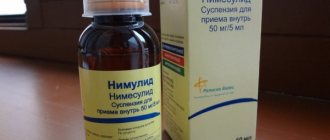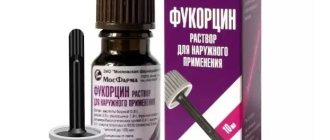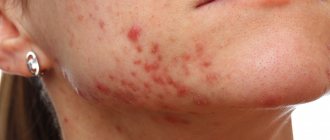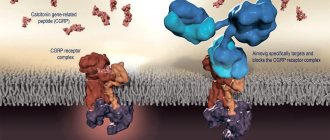Nise
NSAIDs. A selective inhibitor of COX-2, an enzyme involved in the synthesis of prostaglandins - mediators of edema, inflammation and pain. The drug has anti-inflammatory, analgesic and antipyretic effects.
Reversibly inhibits the formation of prostaglandin E2, both at the site of inflammation and in the ascending pathways of the nociceptive system, including the pathways of pain impulses in the spinal cord.
Reduces the concentration of short-lived prostaglandin H2, from which prostaglandin E2 is formed under the action of prostaglandin isomerase. A decrease in the concentration of prostaglandin E2 leads to a decrease in the degree of activation of EP-type prostanoid receptors, which is expressed in analgesic and anti-inflammatory effects.
It has a slight effect on COX-1 and practically does not interfere with the formation of prostaglandin E2 from arachidonic acid under physiological conditions, thereby reducing the number of side effects of the drug.
The drug suppresses platelet aggregation by inhibiting the synthesis of endoperoxides and thromboxane A2, and inhibits the synthesis of platelet aggregation factor. Suppresses the release of histamine and also reduces the degree of bronchospasm caused by exposure to histamine and acetaldehyde.
The drug also inhibits the release of tumor necrosis factor alpha, which causes the formation of cytokines.
It has been shown that nimesulide is able to suppress the synthesis of interleukin-6 and urokinase, thereby preventing the destruction of cartilage tissue. Inhibits the synthesis of metalloproteases (elastase, collagenase), preventing the destruction of proteoglycans and collagen of cartilage tissue.
It has antioxidant properties and inhibits the formation of toxic oxygen breakdown products by reducing the activity of myeloperoxidase. Interacts with glucocorticoid receptors, activating them through phosphorylation, which also enhances the anti-inflammatory effect of the drug.
When applied topically, it causes a weakening or disappearance of pain at the site of application of the gel, incl. pain in the joints at rest and during movement, reduces morning stiffness and swelling of the joints. Helps increase range of motion.
Pharmacokinetics
Suction
After oral administration, nimesulide is well absorbed from the gastrointestinal tract. Eating reduces the rate of absorption without affecting its extent. Cmax of nimesulide in blood plasma is achieved 1.5-2.5 hours after administration and is 3.5-6.5 mg/l. Subject to a first-pass effect through the liver.
Distribution
Binding to plasma proteins is 95%, to erythrocytes - 2%, to lipoproteins - 1%, to acidic α1-glycoproteins - 1%. The dose of the drug does not affect the degree of binding to blood proteins.
Vd is 0.19-0.35 l/kg. Penetrates into the tissues of the female genital organs, where after a single dose the concentration of nimesulide is about 40% of the concentration in plasma. Penetrates well into the acidic environment of the inflammation site (40%) and synovial fluid (43%). Easily penetrates histo-hematological barriers.
Metabolism
Nimesulide is actively metabolized in the liver by tissue monooxygenases. The main metabolite, 4-hydroxynimesulide (25%), has similar pharmacological activity.
Removal
T1/2 - 1.56-4.95 hours, T1/2 of 4-hydroxynimesulide - 2.89-4.78 hours. The metabolite is excreted by the kidneys (65%) and bile (35%).
Pharmacokinetics in special clinical situations
In patients with renal failure (creatinine clearance from 80 to 30 ml/min), as well as in children and the elderly, the pharmacokinetic profile of nimesulide does not change significantly.
Nise®
Glucocorticosteroids: Increase the risk of gastrointestinal ulcers or bleeding.
Antiplatelet agents and selective serotonin reuptake inhibitors: increase the risk of gastrointestinal bleeding.
Anticoagulants: NSAIDs may enhance the effect of anticoagulants such as warfarin. Due to the increased risk of bleeding, this combination is not recommended and is contraindicated in patients with severe coagulation disorders. If combination therapy cannot be avoided, careful monitoring of blood clotting parameters is necessary.
Diuretics: NSAIDs may reduce the effect of diuretics. In healthy volunteers, nimesulide temporarily reduces the excretion of sodium under the influence of furosemide, to a lesser extent the excretion of potassium, and reduces the diuretic effect itself. Co-administration of nimesulide and furosemide leads to a decrease (by approximately 20%) in the area under the concentration-time curve (AUC) and a decrease in the cumulative excretion of furosemide without changing the renal clearance of furosemide. Co-administration of furosemide and nimesulide requires caution in patients with impaired renal or cardiac function.
ACE inhibitors and angiotensin II receptor antagonists: NSAIDs may reduce the effect of antihypertensive drugs. In patients with mild to moderate renal failure (creatinine clearance 30-80 ml/min), when co-administered with ACE inhibitors, angiotensin II receptor antagonists or substances that suppress the cyclooxygenase system (NSAIDs, antiplatelet agents), further deterioration of renal function and the occurrence of acute renal failure, which is usually reversible. These interactions should be considered in patients taking Nise® in combination with ACE inhibitors or angiotensin II receptor antagonists. Therefore, coadministration of these drugs should be used with caution, especially in elderly patients. Patients should be kept adequately hydrated and renal function should be closely monitored after initiating concomitant therapy.
There is evidence that NSAIDs reduce the clearance of lithium, which leads to increased plasma lithium concentrations and its toxicity. When prescribing nimesulide to patients receiving lithium therapy, plasma lithium concentrations should be regularly monitored.
No clinically significant interactions were observed with glibenclamide, theophylline, digoxin, cimetidine and antacid drugs (for example, a combination of aluminum and magnesium hydroxides).
Nimesulide inhibits the activity of the CYP2C9 isoenzyme. When taking drugs metabolized with the participation of this isoenzyme with nimesulide, the concentration of these drugs in plasma may increase.
When used simultaneously with antiepileptic drugs (valproic acid), antifungal drugs (ketoconazole), antituberculosis drugs (isoniazid), amiodarone, methotrexate, methyldopa, amoxicillin in combination with clavulanic acid, an additive hepatotoxic effect is possible.
Due to the high degree of binding of nimesulide to plasma proteins, patients simultaneously taking sulfonamides should be under medical supervision, undergoing examinations at short intervals.
When prescribing nimesulide less than 24 hours before or after taking methotrexate, caution is required, since in such cases the concentration of methotrexate in plasma and, accordingly, the toxic effects of this drug may increase.
Due to their effect on renal prostaglandins, inhibitors of prostaglandin synthetase, such as nimesulide, may increase the nephrotoxicity of cyclosporines.
In vitro studies have shown that nimesulide is displaced from the binding sites by tolbutamide and salicylic acid. Although these interactions were determined in blood plasma, these effects were not observed during clinical use of the drug.
Composition of the drug Nise gel
The main analgesic effect of the gel is due to the non-steroidal anti-inflammatory substance included in the composition - nimesulide. It, being a selective inhibitor, has fewer side effects and blocks the production of cyclooxygenase, which is activated only at the time of formation of the inflammatory reaction and synthesizes a larger number of prostaglandins. It is the process of synthesis of excess prostaglandins that provokes a number of negative reactions, accompanied by pain, swelling and increased body temperature.
With local inflammation, the temperature rises locally, only at the site of the bruise. Nimesulide inhibits the development of the inflammatory process and soothes the affected area.
The following additional components are used:
- propylene glycol;
- thiomersal;
- butylated hydroxyanisole;
- purified water;
- flavoring
Nise gel is packaged in aluminum tubes, which, in turn, are packaged in cardboard boxes.
Indications for use of Nise gel
Nise gel is prescribed for diseases of the musculoskeletal system. Among them:
- rheumatoid arthritis;
- joint damage by osteoarthritis;
- radiculitis;
- inflammation of ligaments and articular discs, as well as bursitis;
- muscle pain caused by rheumatism;
- exacerbation of gout.
In addition to diseases, Nise gel is recommended for use after injuries:
- bruises;
- sprains;
- dislocations;
- ligament ruptures.
When the joints are affected due to the progression of psoriasis, you can relieve inflammation by rubbing in Nise gel. However, if there is an ulcer or psoriatic plaque on the surface of the skin above the joint, applying the gel is undesirable, especially when any trauma to the surface of the scaly wound leads to bleeding and increased inflammation.
Nise, tablets 100 mg, 20 pcs.
Manufacturer
Dr. Reddy's, India
Compound
Each tablet contains: Active substance: nimesulide 100 mg. Excipients: calcium hydrogen phosphate 75 mg, microcrystalline cellulose (type 114) 40 mg, corn starch 54 mg, sodium carboxymethyl starch 35 mg, magnesium stearate 3 mg, colloidal silicon dioxide 2 mg, talc 1 mg.
pharmachologic effect
Pharmacotherapeutic group: non-steroidal anti-inflammatory drug (NSAID).
CodeATX:M01AX17. Pharmacological properties Pharmacodynamics
Non-steroidal anti-inflammatory drug (NSAID) from the sulfonanilide class. It is a selective competitive inhibitor of cyclooxygenase-2 (COX-2), inhibits the synthesis of prostaglandins at the site of inflammation. The inhibitory effect on COX-1 is less pronounced (less likely to cause side effects associated with inhibition of prostaglandin synthesis in healthy tissues). It has anti-inflammatory, analgesic and pronounced antipyretic effects.
Pharmacokinetics
Absorption when taken orally is high (food intake reduces the rate of absorption without affecting its degree). Time to reach maximum concentration (Tmax) - 1.5-2.5 hours. Communication with plasma proteins - 95%, with erythrocytes - 2%, with lipoproteins - 1%, with acidic alpha glycoproteins - 1%. Changing the dose does not affect the degree of binding. The maximum concentration value (Cmax) is 3.5-6.5 mg/l. Volume of distribution - 0.19-0.35 l/kg. Penetrates into the tissues of the female genital organs, where after a single dose its concentration is about 40% of the concentration in plasma. Penetrates well into the acidic environment of the inflammation site (40%) and synovial fluid (43%). Easily penetrates histohematic barriers.
Metabolized in the liver by tissue monooxygenases. The main metabolite, 4-hydroxynimesulide (25%), has similar pharmacological activity, but due to a decrease in molecular size, it is able to quickly diffuse through the hydrophobic COX-2 channel to the active binding site of the methyl group. 4-hydroxynimesulide is a water-soluble compound, the elimination of which does not require glutathione and conjugation reactions of phase II metabolism (sulfation, glucuronidation, etc.).
The half-life (T1/2) of nimesulide is 1.56-4.95 hours, 4-hydroxynimesulide is 2.89-4.78 hours. 4-hydroxynimesulide is excreted by the kidneys (65%) and bile (35%), is subject to enterohepatic recycling.
In patients with renal failure (creatinine clearance 1.8-4.8 l/h or 30-80 ml/min), as well as in children and the elderly, the pharmacokinetic profile of nimesulide does not change significantly.
Indications
- rheumatoid arthritis; - articular syndrome during exacerbation of gout; - psoriatic arthritis;
- ankylosing spondylitis;
— osteochondrosis with radicular syndrome;
- osteoarthritis;
— myalgia of rheumatic and non-rheumatic origin;
- inflammation of ligaments, tendons, bursitis, including post-traumatic inflammation of soft tissues;
- pain syndrome of various origins (including in the postoperative period, with injuries, algodismenorrhea, toothache, headache, arthralgia, lumbar ischialgia).
The drug is intended for symptomatic therapy, reducing pain and inflammation at the time of use, and does not affect the progression of the disease.
Contraindications
- Hypersensitivity to the active substance or auxiliary components;
- complete or incomplete combination of bronchial asthma, recurrent polyposis of the nose or paranasal sinuses and intolerance to acetylsalicylic acid and other NSAIDs (including a history);
- erosive and ulcerative changes in the mucous membrane of the stomach and duodenum (duodenum), active gastrointestinal bleeding, cerebrovascular or other bleeding;
- inflammatory bowel diseases (Crohn's disease, ulcerative colitis) in the acute phase;
- hemophilia and other bleeding disorders;
- decompensated heart failure;
- liver failure or any active liver disease;
- anamnestic data on the development of hepatotoxic reactions when using nimesulide preparations;
- concomitant use of potentially hepatotoxic substances;
- alcoholism, drug addiction;
- severe renal failure (creatinine clearance less than 30 ml/min), progressive kidney disease, confirmed hyperkalemia;
- period after coronary artery bypass surgery;
- pregnancy, lactation period;
- children's age up to 12 years.
Carefully
Coronary heart disease, cerebrovascular disease, congestive heart failure, dyslipidemia/hyperlipidemia, diabetes mellitus, peripheral arterial disease, smoking, creatinine clearance less than 60 ml/min. Anamnestic data on the development of ulcerative lesions of the gastrointestinal tract, the presence of Helicobacter pylori infection, old age, long-term use of NSAIDs, frequent alcohol consumption, severe somatic diseases, concomitant therapy with anticoagulants (for example, warfarin), antiplatelet agents (for example, acetylsalicylic acid, clopidogrel), oral glucocorticosteroids ( for example, prednisolone), selective serotonin reuptake inhibitors (for example, citalopram, fluoxetine, paroxetine, sertraline).
Side effects
The frequency of side effects is classified depending on the frequency of occurrence: often - (1-10%), sometimes (0.1-1%), rarely (0.01-0.1%), very rarely (less than 0.01% ), including individual messages.
Allergic reactions: rarely - hypersensitivity reactions; very rarely - anaphylactoid reactions.
From the central nervous system: infrequently - dizziness; rarely - a feeling of fear, nervousness, nightmares; very rarely - headache, drowsiness, encephalopathy (Reis syndrome).
From the skin: infrequently - itching, rash, increased sweating; rarely: erythema, dermatitis; very rare: urticaria, angioedema, facial swelling, erythema multiforme, including Stevens-Johnson syndrome, toxic epidermal necrolysis (Lyell's syndrome).
From the urinary system: infrequently - swelling; rarely - dysuria, hematuria, urinary retention, hyperkalemia; very rarely - renal failure, oliguria, interstitial nephritis.
From the gastrointestinal tract: often - diarrhea, nausea, vomiting; infrequently - constipation, flatulence, gastritis; very rarely - abdominal pain, stomatitis, tarry stools, gastrointestinal bleeding, ulcer and/or perforation of the stomach or duodenum.
From the liver and biliary system: often - increased “liver” transaminases; very rarely - hepatitis, fulminant hepatitis, jaundice, cholestasis.
From the hematopoietic organs: rarely - anemia, eosinophilia; very rarely - thrombocytopenia, pancytopenia, purpura, prolonged bleeding time.
From the respiratory system: infrequently - shortness of breath; very rarely - exacerbation of bronchial asthma, bronchospasm.
From the senses: rarely - blurred vision.
From the cardiovascular system: infrequently - arterial hypertension; rarely - tachycardia, hemorrhages, hot flashes. Other: rarely - general weakness; very rarely - hypothermia.
Interaction
The effect of medications that reduce blood clotting is enhanced when used simultaneously with nimesulide.
Nimesulide may reduce the effect of furosemide. Nimesulide may increase the possibility of side effects while taking methotrexate.
Plasma lithium levels increase when lithium and nimesulide are taken simultaneously.
Nimesulide may enhance the effect of cyclosporine on the kidneys.
Use with glucocorticosteroids and serotonin reuptake inhibitors increases the risk of gastrointestinal bleeding.
How to take, course of administration and dosage
The minimum effective dose should be used for the shortest possible short course. The tablets are taken with enough water, preferably after meals. Adults and children over 12 years of age, take 1 tablet orally 2 times a day. If you have diseases of the gastrointestinal tract, it is advisable to take the drug at the end of a meal or after a meal. The maximum daily dose for adults is 200 mg. Patients with chronic renal failure require a reduction in the daily dose to 100 mg.
Overdose
Symptoms: apathy, drowsiness, nausea, vomiting. Gastrointestinal bleeding, increased blood pressure, acute renal failure, and respiratory depression may occur.
Treatment: The patient requires symptomatic treatment and supportive care. There is no specific antidote. If an overdose occurs within the last 4 hours, it is necessary to induce vomiting, take activated carbon (60-100 g per adult), and osmotic laxatives. Forced diuresis and hemodialysis are ineffective due to the high binding of the drug to proteins.
Special instructions
Since Nise® is partially excreted by the kidneys, its dose should be reduced in patients with impaired renal function, depending on creatinine clearance. Given reports of visual disturbances in patients taking other NSAIDs, treatment should be stopped immediately if any visual disturbance occurs and the patient should be examined by an ophthalmologist.
The drug can cause fluid retention in tissues, so patients with high blood pressure and cardiac problems should use Nise® with extreme caution.
Patients should undergo regular medical monitoring if they, along with nimesulide, take medications that are characterized by an effect on the gastrointestinal tract.
If signs of liver damage appear (itching, yellowing of the skin, nausea, vomiting, abdominal pain, dark urine, increased levels of liver transaminases), you should stop taking the drug and consult your doctor. The drug should not be used simultaneously with other NSAIDs.
The drug can change the properties of platelets, but does not replace the preventive effect of acetylsalicylic acid in cardiovascular diseases. The use of the drug may adversely affect female fertility and is not recommended for women planning pregnancy.
After 2 weeks of using the drug, monitoring of biochemical indicators of liver function is necessary.
This dosage form is contraindicated for children under 12 years of age, but if it is necessary to use nimesulide in children over 7 years of age, 50 mg dispersible tablets and suspension can be used in strict accordance with the instructions for medical use attached to them.
Since the drug can cause drowsiness, dizziness and blurred vision, care must be taken when driving vehicles and engaging in other potentially hazardous activities that require increased concentration and speed of psychomotor reactions.
Storage conditions
List B. In a dry place, protected from light, at a temperature not exceeding 25°C. Keep out of the reach of children!
Best before date
3 years
Active substance
Nimesulide
Conditions for dispensing from pharmacies
On prescription
Dosage form
pills
Purpose
For adults as prescribed by a doctor, Children over 12 years old, Children as prescribed by a doctor
Indications
Migraine, Radiculitis, Bursitis, Arthritis, Gout, Dislocations and sprains, Tendon inflammation, Myositis, Osteochondrosis, Rheumatoid arthritis, Sciatica, Arthrosis, Lumbago
Barcode and weight
Barcode: 8901148052031, 8901148005836, 8901148236608, 0118901148005 Weight: 0.013 kg





